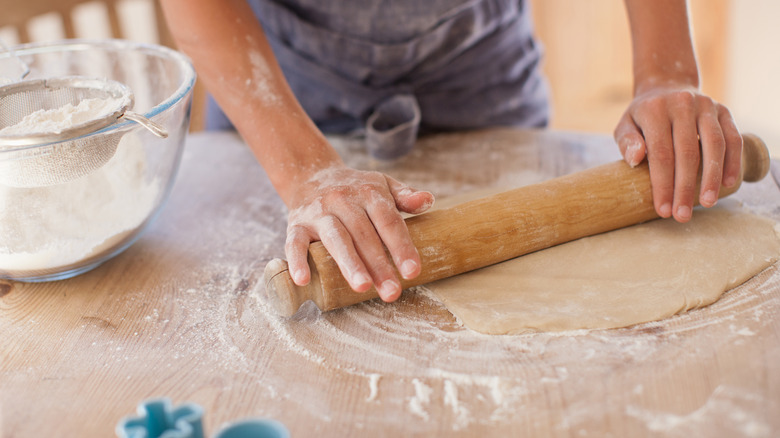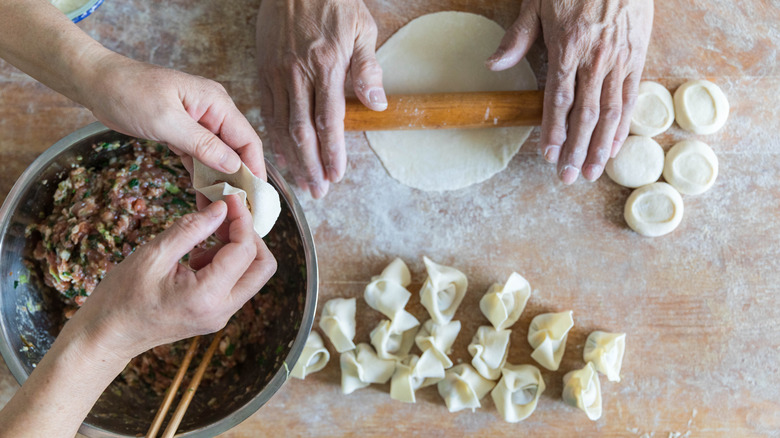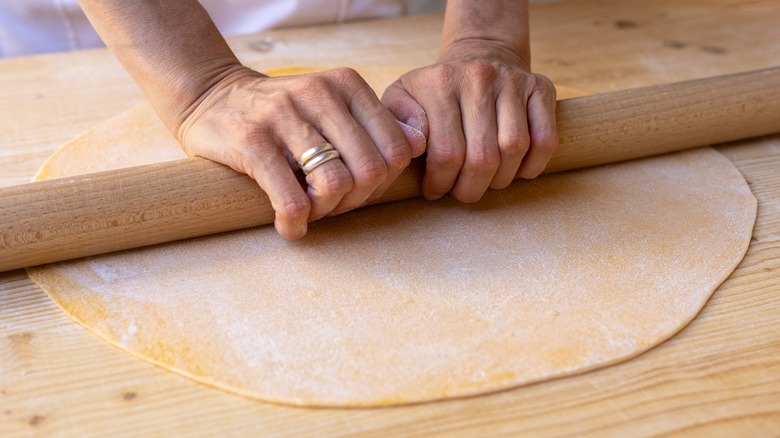The Rolling Pin Mistake That Can Derail Delicate Homemade Pasta
Store-bought pasta is fine if you don't have a lot of time for making meals, but if you really want to make a plate of Bucatini Cacio E Pepe that'll knock your dinner guests' socks off, you need to try your hand at fresh homemade pasta. Your first attempt most likely won't look very good, but trust that the effort will be worth it: Homemade pasta is just leagues above the dried varieties you'll find at the grocery store.
You don't need lots of tools to start: Homemade pasta can be made with as little as two ingredients, and machines are optional. You can make it with a pasta maker or rolled by hand. The former is more convenient, but the latter, while requiring some elbow grease on your part, will give you much better pasta. You'll get a better texture by rolling the pasta strands by hand with a wooden rolling pin, which will allow it to take to sauces more easily and have a better mouthfeel. However, if you choose this method, making sure that your rolling pin and surface are perfectly flat is crucial!
You see, wooden rolling pins will warp over time, either from use or exposure to the environment. If they're a bit warped and you try to roll your pasta with it, the pasta strands will come out misshapen. This can be very bad news when working with delicate varieties like sfoglia, where uniformity is key.
Why flatness matters in making homemade pasta
Watch closely as you lay out your pasta dough and flatten it with a rolling pin. You'll notice the dough gradually stretching and thinning with each pass of the rolling pin. By ensuring that your rolling pin is as flat and even as possible relative to the surface, you'll have much greater control over the final thickness of your pasta sheet. If the rolling pin isn't even, you'll have parts that are too thick, while others are thin. An unevenly rolled sheet can create a wonky and lumpy base dough, and if you're trying to make noodles like fettuccine and tagliatelle by hand, that can ruin the cooking session.
That said, the same rule applies no matter what type of pasta you're making. Take ravioli, for instance — once you've finished stretching the base dough, folding and shaping it by hand will be significantly easier if you're working with a uniform sheet. You'll also have an easier time cooking pasta that's cut from an even base dough. Without any thin spots that overcook or thick spots that remain undercooked, your pasta will come out nicely without giving you any unpleasant surprises.
Making sure your rolling pin is in tip-top shape
If you have an inkling that your rolling pin may be a bit out of shape, it's a good idea to do a small sample test. Cut out a small piece of fresh pasta, then roll it as thin as you can. The thinner the sheet, the easier it will be to spot any badly-shaped spots.
Do note that French-style rolling pins are tapered, so a gentle curve along the pasta sheet is to be expected. If the thickness there is uniform along the entire sheet, then your rolling pin is working exactly as intended. It's only a problem if you see scattered thin and thick spots, or areas that are clearly uneven all across your dough, whether on the tapered part or right in the center. Using a flat-style pin? Roll it over a flat surface. The barrel of these rolling pins is designed to be smooth, so if they wobble, there's something wrong.
What happens next, if you've just found out that your rolling pin is no longer up to code? Well, unless you're very good at woodworking, your only choice is to replace it with a new one. But no worries, new rolling pins are often affordable, and they last a long time these days. Take care of that shiny new purchase properly, and you'll be able to keep rolling out fresh batches with it for years to come.


